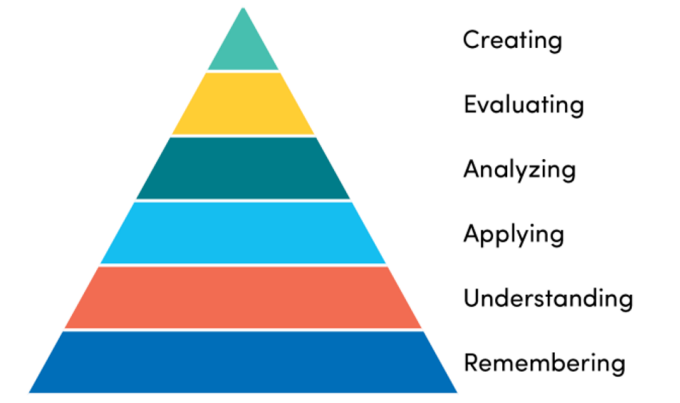Bloom's Revised Taxonomy
Organizing learning outcomes by cognitive complexity.
On this page:
When designing a course’s learning outcomes, it is important to understand the complexity of student tasks. For example, should students be able to compare two works of literature before they apply similar concepts to their own writing? Using a framework like Bloom’s helps determine the cognitive complexity of student tasks, whether there is variety of difficulty among learning outcomes and, if not, how to alter them to create variety.

Bloom’s Taxonomic Pyramid
Bloom’s Taxonomic Pyramid orders the levels of outcomes from the lowest order of cognition (remembering) to the highest (creating) (Krathwohl, 2002). In the following table we have given a brief description of what these levels mean, as well as example learning outcomes in a cooking class where students are learning to make omelettes.
The Meaning of Bloom's Levels
| Level | Students can... | Examples for making an omelette in a culinary class |
|---|---|---|
| Creating | Use elements to form an original product. | Construct a new recipe influenced by the ingredients of a specified country. |
| Evaluating | Make judgments based on criteria. | Argue for how a recipe might be improved. |
| Analyzing | Determine parts, their purpose and their relation to each other and the whole. | Compare two omelette recipes and predict how they will turn out. |
| Applying | Carry out a procedure in a given situation. | Demonstrate how to cook an omelette. |
| Understanding | Determine meaning. | Describe how each ingredient contributes to an omelette. |
| Remembering | Retrieve knowledge. | Remember ingredients for French Omelette. |
Important Points About Complexity
There are a several important points to note about levels of complexity.
- Higher levels are often more complex
While higher levels may be more difficult, this is not always the case. For example, the complexity or difficulty of a student creating a song may be low (e.g., sing any melody) or high (e.g., incorporate a full orchestra). - Levels build off each other
In order to analyze content, students need to know and understand the parts or there is nothing to analyze. While levels often build off each other, students can be introduced to, and complete, levels at higher tasks earlier. For example, asking students to cook a souffle first, and then analyze what worked and what went wrong to better understand the chemistry of cooking uses several levels together. - Variety of levels
If all learning outcomes are at the same level, students will not develop well-rounded skills. An entry-level course may require students to mainly remember, understand and apply concepts, while a higher-level course might focus more on evaluation and creation. - Scaffolding
Beginning students can practice higher levels of complexity with appropriate scaffolding (see scaffolding). For example, when asking students to create a short story you might limit page length, number of characters, location etc.
To create a variety of appropriate learning outcomes for students:
- Use this verb chart to categorize your learning outcomes by Bloom’s six levels.
- Determine which levels are appropriate for your course and which are missing. Some will exist in multiple categories and complexity will depend on the focus of the learning outcome.
- Adjust or create new outcomes using the verb chart by choosing new verbs in the appropriate categories. Are these balanced?
Information page discussing the expansion of Bloom’s Taxonomy by Anderson et al. (2001) to include a cognitive process dimension, in addition to the knowledge dimension.
Interactive wheel illustrating Bloom’s levels of cognitive complexity, the verbs that align with each level of complexity and appropriate assessment techniques for each level.
- Anderson, L. W., Krathwohl, D. R., Airasian, P. W., Cruikshank, K. A., Mayer, R. E., Pintrich, P. R., ... & Wittrock, M. C. (2001). A taxonomy for learning, teaching, and assessing: A revision of Bloom’s taxonomy of educational objectives, abridged edition. White Plains, NY: Longman.
- Krathwohl, D. R. (2002). A revision of Bloom's taxonomy: An overview. Theory into practice, 41(4), 212-218.
- Stanny, C. J. (2016). Reevaluating Bloom’s Taxonomy: What Measurable Verbs Can and Cannot Say about Student Learning. Education Sciences, 6(4), 37.